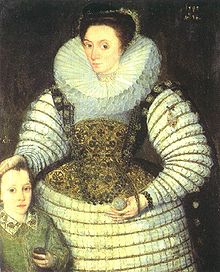Robert Devereux, 3rd Earl of Essex
Robert Devereux, 3rd Earl of Essex, KB, PC (/ˈdɛvəˌruː/; 11 January 1591 – 14 September 1646) was an English Parliamentarian and soldier during the first half of the 17th century.
[3] Essex claimed that he was only impotent with her and had been perfectly capable with other women, adding that she "reviled him, and miscalled him, terming him a cow and coward, and beast.
It was small comfort that the finding that Frances was still a virgin was greeted with equal derision: as a popular ballad put it The Dame was inspected, but fraud interjected a Maid of greater perfection.
Three years later the Somersets were tried by a panel of Lords for their part in the murder of Sir Thomas Overbury; Essex sat as a juror in the trial of his former wife and pressed the King to send her to the scaffold.
Elizabeth was introduced at Court during the Great Parliament of 1628/29 just after her father died, as the eldest unmarried daughter needing to marry to improve her family prospects.
Back from travels in military service on the Continent (see below) Robert was also pressured to marry again (and quickly) to show the Court the humiliation from his first marriage could be overcome.
[citation needed] There was a son from the union, Robert, styled Viscount Hereford, who was born on 5 November 1636 and died of plague a month later.
Essex, who had given the birth date as a deadline beyond which he would have disowned the child,[6] grudgingly acknowledged him as his own; however, the father was widely suspected by the Court to be Elizabeth's alleged lover, Sir Thomas Uvedale (from the alleged prompting of William Seymour, 1st Marquess of Hertford, Robert's brother-in-law who leased part of Essex House in London, and expected to inherit if Robert had no issue).
[citation needed] In 1620 Essex embarked on what was to be an undistinguished military career prior to the start of the First English Civil War.
[8] In 1625, under Sir Edward Cecil, he commanded a squadron as vice-admiral and as colonel of a foot regiment in the failed English expedition to Cadiz.
[6] Despite the lack of distinction, this period of his life gave him a good working knowledge of continental war methods and strategies, even if most of his own experience was limited to defensive operations.
In 1641, Parliament passed a Bill of Attainder against the King's minister Thomas Wentworth, Earl of Strafford, who was fiercely loyal to Charles.
In an attempt at reconciliation with Parliament, Charles gave royal assent to the Bill of Attainder and invited leading Parliamentary critics to join his Privy Council.
Parliament also bolstered his territorial power by reappointing him Lord Lieutenant of the counties of Yorkshire and Staffordshire, and appointing him that of Montgomeryshire, Herefordshire and Shropshire.
The Parliamentary ordinance that commissioned Essex to his post of Captain-General gave him the task of "preserving the Safety of his Majesty's Person".
It conveniently blamed the brewing troubles on those surrounding the King rather than Charles himself, specifically "the cunning practice of Papists, and malicious Counsels of divers ill-affected Persons, inciting his Majesty to raise men".
Essex's lifeguard included Henry Ireton, Charles Fleetwood, Thomas Harrison, Nathaniel Rich, Edmund Ludlow, Matthew Tomlinson and Francis Russell.
All of them played a leading role in the civil war and its aftermath but a degree of amateurism and bad discipline was evident on both sides during the battle.
Following a brief exchange of artillery fire, the battle began with a Royalist cavalry charge led by Prince Rupert of the Rhine.
As the rival infantry divisions engaged in combat, with Essex fighting alongside his troops with a pike,[14] the two remaining Parliamentarian cavalry regiments made a devastating attack on the exposed Royalist foot soldiers.
Both sides incurred heavy losses and the battle ended in stalemate after Rupert's cavalry returned to stop a rout.
The King chose to make an assault on London with his army at full strength, as he too was awaiting the arrival of more soldiers from around the country.
Essex and Major-General Phillip Skippon were key to this display of force by placing their soldiers in effective defensive positions and by keeping up morale.
By the end of 1642, Essex's forces were the weaker side against the Royalists but the Parliamentarians had the sympathy of the Scots and there were thousands of other troops ready to join their cause around the country.
This was an alliance of pro-Parliament militiamen from Essex, Hertfordshire, Norfolk, Suffolk, Cambridgeshire, Huntingdonshire and Lincolnshire commanded by Edward Montagu, 2nd Earl of Manchester.
The death of Pym in December 1643 led to the demise of the middle group and also deprived Essex of a key ally in the House of Commons.
His conduct in the West Country had frustrated Cromwell, now the most prominent member of the House of Commons following his military victories and the deaths of Hampden and Pym.
Essex and Manchester remained sympathetic to the peace party, while Cromwell had emerged as the leading voice in the campaign to fight a more aggressive war against Charles.
In 1645, Essex was given Somerhill House near Tonbridge, Kent, which had been sequestrated by Parliament from his half-brother Ulick Burke, 5th Earl of Clanricarde, following the Battle of Naseby.
For the occasion, the chancel of the Abbey was draped in black from floor to ceiling and a funeral effigy of the earl dressed in scarlet breeches, a military buff-coat and Parliamentary robes was erected beneath a catafalque designed by Inigo Jones.


by Robert Peake the elder , 1594



